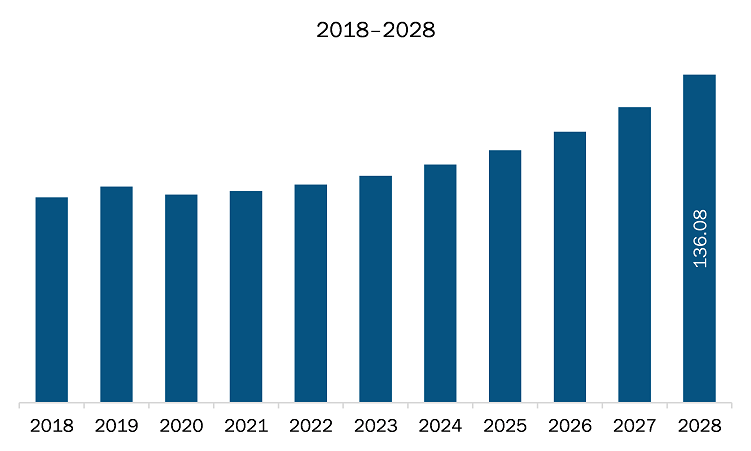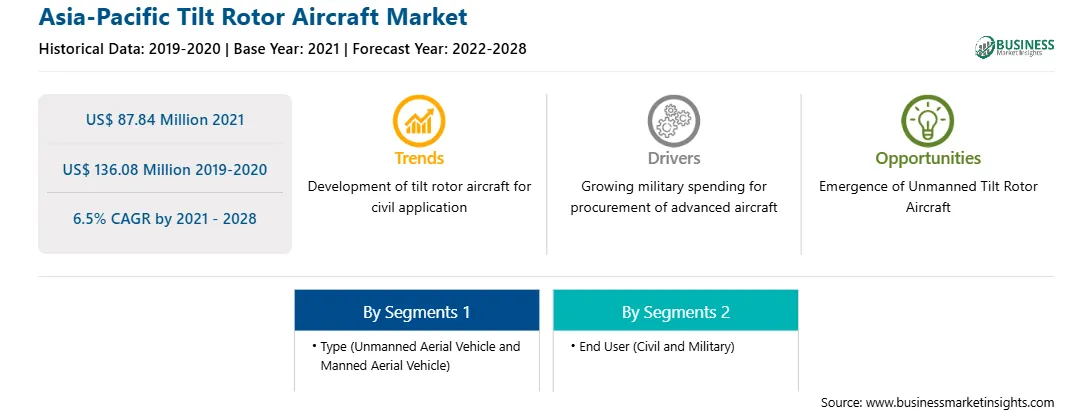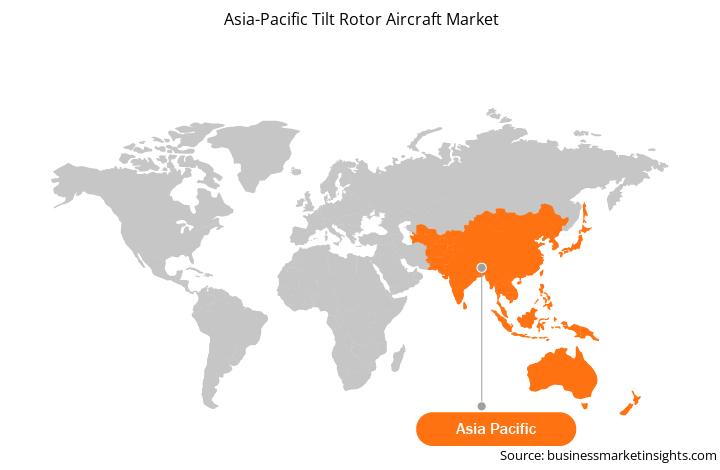The Asia Pacific market is segmented into China, Japan, and Rest of the APAC. The Rest of APAC consist of India, Australia, and South Korea. The region is characterized by the presence of emerging economies who are significant investing for strong arming their military forces. According to SIPRI, China, India, South Korea, and Japan were among the prominent spenders in military expenditure in 2020, spending US$ 252.0 billion, US$ 72.9 billion, US$ 45.7 billion, and US$ 49.1 billion, respectively. Countries such as China and India together accounted more than 60% of overall military expenditure in the region in 2020. Moreover, the region is currently experiencing significant geopolitical flux. For instance, the South Korea and North Korea territorial stress, South China Sea tension, India and China boarder dispute, India and Pakistan boarder tension, China and Russia dispute over Zhenbao Island, and others is among the factor growing the adoption advance military aircraft. The region is also experiencing rise in domestic production of aircraft. For instance, Commercial Aircraft Corporation of China (COMAC), Hindustan Aeronautics Limited (HAL), Kawasaki Heavy Industries (KAI), Aviation Industry Corporation of China (AVIC), Mitsubishi Aircraft Corporation are some leading aircraft manufacturers who are increasing radically increasing footprints in Asia. Further, the region is increasing inclined to towards adoption of advance military aircraft and unmanned ariel vehicles. Countries are increasingly promoting the domestic as well as global manufacturing of unmanned vehicles. Moreover, China has been supplying armed drones to more than 18 countries over the years. From the tilt rotor aircraft perspective, in 2018, China Aerospace Science and Technology Corp unveiled CH-10, a tilt rotor UAV. Also, Japan ordered Bell-Boeing 17 V-22 Osprey in 2015, and Japan Self-Defense Ground Force received first 2 V-22 Osprey in May 2020. Thus, the growing military spending is one of the major factors creating favourable condition for the adoption of advance military aircraft including tilt rotor aircraft.
The tilt rotor aircraft market in APAC suffered minimal disruption as the number of on-going projects and development of such aircraft models is less. China is one of the prominent countries with a number of projects. The country experienced substantial loss during the 1st quarter of 2020. However, Chinese tilt rotor aircraft manufacturers revived their process and have stabilized their development processes. Apart from China, another development in the tilt rotor aircraft market in 2020 took place in Japan, where the country has taken delivery of two V-22 Osprey from Bell-Boeing in May 2020. This development has also stabilized the regions tilt rotor market.

Strategic insights for the Asia-Pacific Tilt Rotor Aircraft provides data-driven analysis of the industry landscape, including current trends, key players, and regional nuances. These insights offer actionable recommendations, enabling readers to differentiate themselves from competitors by identifying untapped segments or developing unique value propositions. Leveraging data analytics, these insights help industry players anticipate the market shifts, whether investors, manufacturers, or other stakeholders. A future-oriented perspective is essential, helping stakeholders anticipate market shifts and position themselves for long-term success in this dynamic region. Ultimately, effective strategic insights empower readers to make informed decisions that drive profitability and achieve their business objectives within the market.

| Report Attribute | Details |
|---|---|
| Market size in 2021 | US$ 87.84 Million |
| Market Size by 2028 | US$ 136.08 Million |
| CAGR (2021 - 2028) | 6.5% |
| Historical Data | 2019-2020 |
| Forecast period | 2022-2028 |
| Segments Covered |
By Type
|
| Regions and Countries Covered | Asia-Pacific
|
| Market leaders and key company profiles |
|
The geographic scope of the Asia-Pacific Tilt Rotor Aircraft refers to the specific areas in which a business operates and competes. Understanding local distinctions, such as diverse consumer preferences (e.g., demand for specific plug types or battery backup durations), varying economic conditions, and regulatory environments, is crucial for tailoring strategies to specific markets. Businesses can expand their reach by identifying underserved areas or adapting their offerings to meet local demands. A clear market focus allows for more effective resource allocation, targeted marketing campaigns, and better positioning against local competitors, ultimately driving growth in those targeted areas.

The tilt rotor aircraft market in APAC is expected to grow from US$ 87.84 million in 2021 to US$ 136.08 million by 2028; it is estimated to grow at a CAGR of 6.5% from 2021 to 2028. Lower Operating Cost of Tilt Rotor Aircraft; A tilt rotor aircraft generates its lift and propulsion with the help of rotors that are mounted at the end of the fixed wing. The rotors are vertically tilted to generate lift and further the aircraft gradually gains forward momentum as the rotors are tilted in horizontal direction. Thus, this enables the aircraft to have vertical take-off and landing capability (VTOL) of a rotary wing aircraft and the range & speed of a fixed wing aircraft. This capability eliminates the need for dedicated landing strip for such aircraft. Also, such aircraft are considered more efficient compared to a rotary wing aircraft when it comes to transporting people and goods within short distance. As rotary wing aircraft are widely used for travelling shorter distance, the operating cost of rotary wing aircraft is generally at higher side compared to fixed wing aircraft. Thus, utilizing tilt rotor aircraft for transportation application enables end users to save significant amount of operation cost. Owing to the aforementioned advantages of tilt rotor aircraft, the market is anticipated to witness steady growth during the forecast period. This is bolstering the growth of the tilt rotor aircraft market.
In terms of type, the Manned Aerial Vehicle segment accounted for the largest share of the APAC tilt rotor aircraft market in 2020. In terms of end user type, the Military segment held a larger market share of the tilt rotor aircraft market in 2020.
A few major primary and secondary sources referred to for preparing this report on the APAC tilt rotor aircraft market are company websites, annual reports, financial reports, national government documents, and statistical database, among others. Major companies listed in the report are Aviation Industry Corporation of China , BAE Systems plc
The Asia-Pacific Tilt Rotor Aircraft Market is valued at US$ 87.84 Million in 2021, it is projected to reach US$ 136.08 Million by 2028.
As per our report Asia-Pacific Tilt Rotor Aircraft Market, the market size is valued at US$ 87.84 Million in 2021, projecting it to reach US$ 136.08 Million by 2028. This translates to a CAGR of approximately 6.5% during the forecast period.
The Asia-Pacific Tilt Rotor Aircraft Market report typically cover these key segments-
The historic period, base year, and forecast period can vary slightly depending on the specific market research report. However, for the Asia-Pacific Tilt Rotor Aircraft Market report:
The Asia-Pacific Tilt Rotor Aircraft Market is populated by several key players, each contributing to its growth and innovation. Some of the major players include:
The Asia-Pacific Tilt Rotor Aircraft Market report is valuable for diverse stakeholders, including:
Essentially, anyone involved in or considering involvement in the Asia-Pacific Tilt Rotor Aircraft Market value chain can benefit from the information contained in a comprehensive market report.